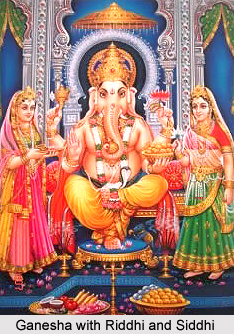 The Puranic texts mention the legend of Haridra Ganapati which is the 21st form among the 32 forms of Lord Ganesha. Haridra Ganapati, also known as Lord Ratri Ganapati, is portrayed in turmeric (Haridra) hue. The deity has four arms and He holds an elephant goad and His broken tusk in His right hands while He carries a noose and a bowl of Modakas in the left hands. The legend mentions that once Goddess Peetambara became immensely pleased with Lord Ganesha. Thus she blessed the elephant-headed deity with a golden complexion and aura.
The Puranic texts mention the legend of Haridra Ganapati which is the 21st form among the 32 forms of Lord Ganesha. Haridra Ganapati, also known as Lord Ratri Ganapati, is portrayed in turmeric (Haridra) hue. The deity has four arms and He holds an elephant goad and His broken tusk in His right hands while He carries a noose and a bowl of Modakas in the left hands. The legend mentions that once Goddess Peetambara became immensely pleased with Lord Ganesha. Thus she blessed the elephant-headed deity with a golden complexion and aura.
Ganesha was adorned in yellow garments (peetambar) and consumed golden Laddoos. The consorts of Lord Ganesha, Riddhi (material welfare) and Siddhi (spiritual prosperity) were seated next to Him. They were dressed in yellow garments and were embellished with gold jewellery and ornaments. Then Goddess Buddhi (wisdom) appeared before Ganesha and permanently attached herself with the Lord. Therefore Lord Ganesha appeared in the form of Haridra Ganesha in Valga Mandalam.
Goddess Bagalamukhi praised and adored the Lord and announced that any person who worships this form of Lord Ganesha will attain the golden phase of life.
This article is a stub. You can enrich by adding more information to it. Send your Write Up to content@indianetzone.com




















